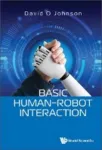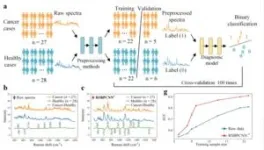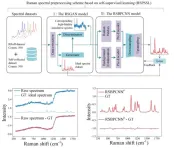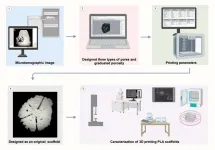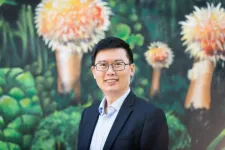(Press-News.org) Basic Human–Robot Interaction by Dr David O Johnson offers practical guidance and insights for conducting experiments in Human–Robot Interaction (HRI) and publishing the results in scientific journals. It includes a detailed explanation of how to conduct an HRI experiment and what to do and what not to do to get an article accepted for publication. It is tailored to those seeking to deepen their understanding of HRI methodologies, statistical measurements, and research design.
The book begins with an overview of HRI, unravelling the basics of how robots function, with a specific focus on the verbal and non-verbal aspects of influencing their interactions with humans. It serves as an essential introduction to those keen on understanding the fundamentals of HRI. A significant portion of the book is dedicated to a detailed explanation of how to conduct HRI experiments, presented as a tutorial for crafting articles destined for HRI scientific journals or conferences. The guide meticulously outlines what actions to take and what to avoid to increase the chances of article acceptance, providing invaluable insights for researchers in the field.
In the ever-evolving field of robotics, a pressing question arises: How can we enable robots to effectively serve and assist us in various tasks such as cleaning or driving? Traditional programming, notably in intricate domains like auto mechanics, may encounter limitations. This is where teaching comes into play as a promising alternative to programming. The concept of teaching, as discerned through apprenticeship by Gross and Krenn (2023), involves a human instructing a robot through speech, gestures, or demonstration (see Chapter 1). This method empowers robots to learn and adapt to individual preferences. Furthermore, robots can acquire knowledge about their surroundings, as demonstrated by an exploration robot learning the intricacies of its environment.
Interestingly, the subject matter expert guiding this learning process is not necessarily a computer scientist or a robot engineer but a human instructor proficient in teaching skills to humans. Additionally, robots have the potential to learn autonomously through trial and error, further expanding their capabilities. This exploration sheds light on the crucial role of teaching and learning in equipping robots with the competence to serve and adapt in various contexts.
The book concludes with a forward-looking perspective on current HRI trends, highlighting technological advancements, social robots, collaborative robots, and natural interaction modalities. It extends beyond technology, addressing human-centered design, user experience, long-term interaction, interdisciplinary research collaborations, and ethical considerations.
Since the case studies and examples featured in the book focus on interactions between social robots and specific demographics such as children and older adults, it is relevant for individuals working in healthcare, education, and related domains.
Covered are common statistical measurements used in HRI research and quantitative, qualitative, and meta-analyses. The concepts are illustrated with several international case studies of interactions between social robots and children and older adults and robot learning instead of programming. The final chapter explores current trends in HRI and provides insights into what to look for in the coming years. It includes an extensive reference section to help HRI researchers in all these areas.
This book will appeal to an international audience of advanced students, researchers, industry, and others who are actively engaged or interested in the field of HRI.
Basic Human–Robot Interaction retails for US$148 / £135 (hardcover) and is also available in electronic formats. To order or know more about the book, visit http://www.worldscientific.com/worldscibooks/10.1142/13581.
###
About the Author
Dr. David O. Johnson is an Associate Teaching Professor of Electrical Engineering and Computer Science at the University of Kansas in Lawrence, KS, USA. His research interests are in human robot interaction, artificial intelligence, machine learning, and natural language processing. He received his PhD in Computer Science in 2009 after working in industry for 31 years. His dissertation was entitled, Human Robot Interaction Through Semantic Integration of Multiple Modalities, Dialog Management, and Contexts. Prior to teaching at the University of Kansas, he was an Adjunct Professor of Computer Science at the University of Missouri–Kansas City, USA. He also completed a post-doctoral assignment at the Eindhoven University of Technology in Eindhoven, NL where he assisted in the development of the HRI software for the international KSERA project. He also completed a post-doctoral assignment at Northern Arizona University in Flagstaff, AZ, USA where he developed natural language processing software to automatically assess English oral proficiency for which he holds a patent. He wrote a chapter on artificial intelligence in Medical Applications of Artificial Intelligence by CRC Press. He co-authored a book called Second Language Prosody and Computer Modeling by Taylor & Francis. He is one of the principle authors on several journal and conference papers about human-robot interaction and computer modelling of language prosody. He is also a frequent reviewer for the International Journal of Social Robotics and other HRI related publications.
About World Scientific Publishing Co.
World Scientific Publishing is a leading international independent publisher of books and journals for the scholarly, research and professional communities. World Scientific collaborates with prestigious organisations like the Nobel Foundation and US National Academies Press to bring high quality academic and professional content to researchers and academics worldwide. The company publishes about 600 books and over 170 journals in various fields annually. To find out more about World Scientific, please visit www.worldscientific.com.
For more information, contact WSPC Communications at communications@wspc.com.
END
How to conduct a Human-Robot Interaction experiment
And get an article accepted for publication
2024-03-06
ELSE PRESS RELEASES FROM THIS DATE:
Unveiling the sun from behind the clouds: Reshaping the chemical image resolution
2024-03-06
Raman spectral preprocessing
Raman spectroscopy detects the molecular bond information of the chemical components of the sample in situ in a non-destructive and label-free manner (Terms >>>). It is an emerging metabolic-related spectromics technology in biological and clinical medical research and is expected to promote the evolution of precision medicine. At present, Raman spectroscopy is applied in biomedical detections of body fluids, exosomes, cells/microbes, and tissues, among which Raman ...
How do we control the size and shape of pores in 3D scaffolds?
2024-03-06
This article was directed and written by Dr. Lucía Pérez Sánchez, Ldi. Misael A. Ortiz de la O, Dr. Marco Antonio Álvarez Pérez and Dr. Janeth Serrano Bello (Laboratorio de Bioingeniería de Tejidos, División de Estudios de Posgrado e Investigación, Facultad de Odontología, UNAM) Dra. Monserrat Llaguno Munive (Laboratorio de Física Médica, Subdirección de Investigación Básica, Instituto Nacional de Cancerología) and Dr. Osmar A. Chanes Cuevas (Laboratorio de Investigación ...
Liquid lens based holographic camera for real 3D scene hologram acquisition using end-to-end physical model-driven network
2024-03-06
Holography technology can restore the complete light field information of the recorded object, which has important applications in fields like biological microscopic imaging and optical micromanipulation. One important frontier of holography is the reconstruction of realistic 3D scenes. However, the development and application of holographic technology have been hindered by the huge amount of data of the 3D scenes and the laser coherence, which leads to the slow capturing speed of the real 3D scenes ...
Visibility restoration for real-world hazy images via improved physical model and gaussian total variation
2024-03-06
Under real-world haze conditions, the captured images not only suffer from the haze but also are affected by the noise, which significantly deteriorates the visibility of images. However, most of existing haze removal methods mainly focus on the haze degradation and fail to consider the noise interference.
To address the above issue, a research team led by Hailing XIONG and Yun LIU published their new research on 15 Feb 2024 in Frontiers of Computer Science co-published by Higher Education Press and Springer Nature.
The team proposed a novel unified variational model consisting of multiple effective constraints that simultaneously ...
Breakthrough discovery will improve medical monitoring, preventive care for elephants
2024-03-06
SAN DIEGO–—Elephants are the natural carriers of a virus called Elephant Endotheliotropic Herpesvirus (EEHV) that can, for yet unknown reasons, cause profound clinical signs in some young elephants and be rapidly fatal. For nearly two decades, zoos and university partners have been working to study the virus and develop early detection protocols and treatment options.
Veterinarians and clinical pathology researchers at San Diego Zoo Wildlife Alliance (SDZWA) and the University of Copenhagen, Denmark, have recently made an important discovery, now published in the March 2024 Journal of Zoo and Wildlife Medicine. They found that population-based reference ...
Coaches can boost athletes’ mental health by being ‘authentic leaders’
2024-03-06
Sports coaches could strengthen athletes’ mental health and protect them from mental illness – by adopting an ‘authentic leadership’ style, a new study reveals.
Researchers found when athletes perceived that their coach engaged in behaviours such as openly sharing information, showing understanding of their strengths and weaknesses, acting in an ethical manner, and listening to alternative perspectives, they felt happier and dealt with problems more easily.
Publishing their findings today (6 March) in Psychology of Sport and Exercise, experts from the University of Birmingham reveal ...
Short-term exposure to high levels of air pollution kills 1 million globally every year
2024-03-06
Every year, more than one million deaths globally occur because of exposure to short-term (hours to days) fine particulate matter (PM2.5) in air pollution, according to a new report, with Eastern Asia reporting more than 50% of deaths attributable to short-term PM2.5 globally.
To date most studies have focused on the health impacts of living in cities where pollution levels are consistently high, ignoring the frequent “spikes” in pollution that can impact smaller urban areas that occur for instance landscape fires, dust, and other intermittent ...
Living in “leafy” areas may boost bone density and lower osteoporosis risk
2024-03-06
Living in leafy areas near gardens, parks, and green spaces, may boost bone density and lower the risk of osteoporosis, finds research published online in the Annals of the Rheumatic Diseases.
Lower levels of air pollution in green spaces is a significant contributory factor to the associations found, conclude the researchers.
Osteoporosis weakens bones, making them fragile and prone to fracture. It can lead to chronic pain, diminished mobility, and poorer quality of life. Already a major health issue worldwide, its global prevalence is set to rise with the rapid ageing of the population and changes in ...
Taking 9000 to 10000 steps daily may counteract the risk of death and cardiovascular disease in highly sedentary people
2024-03-06
Every additional step up to around 10,000 steps per day reduces the risk of death and cardiovascular disease (CVD), regardless of how much remaining time is spent sedentary, reports a large population-based study published online in the British Journal of Sports Medicine.
Some previous studies have shown that greater daily step counts are associated with lower levels of death and CVD, while others have linked high levels of sedentary behaviour with increased risks of CVD and death. However, none of these studies investigated whether high levels of physical activity may offset or lessen the higher risk of death and CVD ...
Even low levels of leisure time physical activity help to lower stroke risk
2024-03-06
Even people whose physical activity levels fall short of recommended guidelines, but who manage to do some during their leisure time, are likely to have a lower risk of stroke than their sedentary peers, suggests a pooled data analysis of the available evidence, published online in the Journal of Neurology Neurosurgery & Psychiatry.
The effects are independent of age and sex, the findings show, prompting the authors to suggest that everyone should be encouraged to do whatever level of physical activity they can manage in their leisure time.
There’s no doubt that ...
LAST 30 PRESS RELEASES:
New expert guidance urges caution before surgery for patients with treatment-resistant constipation
Solar hydrogen can now be produced efficiently without the scarce metal platinum
Sleeping in on weekends may help boost teens’ mental health
Study: Teens use cellphones for an hour a day at school
After more than two years of war, Palestinian children are hungry, denied education and “like the living dead”
The untold story of life with Prader-Willi syndrome - according to the siblings who live it
How the parasite that ‘gave up sex’ found more hosts – and why its victory won’t last
When is it time to jump? The boiling frog problem of AI use in physics education
Twitter data reveals partisan divide in understanding why pollen season's getting worse
AI is quick but risky for updating old software
Revolutionizing biosecurity: new multi-omics framework to transform invasive species management
From ancient herb to modern medicine: new review unveils the multi-targeted healing potential of Borago officinalis
Building a global scientific community: Biological Diversity Journal announces dual recruitment of Editorial Board and Youth Editorial Board members
Microbes that break down antibiotics help protect ecosystems under drug pollution
Smart biochar that remembers pollutants offers a new way to clean water and recycle biomass
Rice genes matter more than domestication in shaping plant microbiomes
Ticking time bomb: Some farmers report as many as 70 tick encounters over a 6-month period
Turning garden and crop waste into plastics
Scientists discover ‘platypus galaxies’ in the early universe
Seeing thyroid cancer in a new light: when AI meets label-free imaging in the operating room
Neutrophil-to-lymphocyte ratio may aid risk stratification in depressive disorder
2026 Seismological Society of America Annual Meeting
AI-powered ECG analysis offers promising path for early detection of chronic obstructive pulmonary disease, says Mount Sinai researchers
GIMM uncovers flaws in lab-grown heart cells and paves the way for improved treatments
Cracking the evolutionary code of sleep
Medications could help the aging brain cope with surgery, memory impairment
Back pain linked to worse sleep years later in men over 65, according to study
CDC urges ‘shared decision-making’ on some childhood vaccines; many unclear about what that means
New research finds that an ‘equal treatment’ approach to economic opportunity advertising can backfire
Researchers create shape-shifting, self-navigating microparticles
[Press-News.org] How to conduct a Human-Robot Interaction experimentAnd get an article accepted for publication
